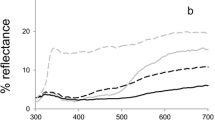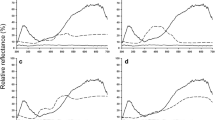Abstract
Deimatic displays are a type of anti-predator behaviour that startles the predator. They have received much recent theoretical attention, enabling the empirical study of this phenomenon within a predictive framework. It has long been known that bluetongue skinks (Tiliqua spp.), when approached by predators, open their mouth widely and expose a conspicuously coloured tongue. Here, we test whether such ‘full-tongue’ displays are triggered by an imminent predatory attack in the Northern Bluetongue skink Tiliqua scincoides intermedia and examine whether this display behaviour is consistent with the predictions from deimatic display theory. First, we demonstrate that luminance at the rear of the tongue, which is only exposed during full-tongue displays, is almost twice as high for lizard and bird receivers compared to the tip of the tongue, and that tongue colouration is generally more conspicuous to a bird than a lizard visual system. Second, staged predatory encounters using model predators reveal that lizards primarily exhibit full-tongue displays in the final stages of a predatory attack. Lizards performed full-tongue displays congruent with the predictions associated with deimatic displays, i.e. rapid exposure of conspicuous elements from a previously inconspicuous state concurrently with aggressive defensive behaviour, most frequently during the final stages of a predatory encounter. Surprisingly, we also found that lizards vary the area of the tongue exposed during chemoexploratory tongue-flicks depending on whether a predator is present or absent.
Significance statement
Bluetongue skinks have long been known to expose their large blue tongue in response to predatory threats. However, this behaviour has never been investigated empirically. Here, we use Northern Bluetongue skinks (Tiliqua scincoides intermedia) to test whether this behaviour is consistent with predictions associated with deimatic displays. We show that the rear of their tongue is UV-blue and more conspicuous to predators compared to the tip and that this ‘full-tongue display’ is only triggered in the final stages of a predatory attack.





Similar content being viewed by others
References
Abramjan A, Bauerová A, Somerová B, Frynta D (2015) Why is the tongue of blue-tongued skinks blue? Reflectance of lingual surface and its consequences for visual perception by conspecifics and predators. Naturwissenschaften 102:1–12
Bateman AW, Vos M, Anholt BR (2014) When to defend: antipredator defenses and the predation sequence. Am Nat 183:847–855
Bates D, Maechler M, Bolker B, Walker S (2014) lme4: linear mixed-effects models using Eigen and S4. R package version, 1(7). https://CRAN.R-project.org/package=lme4
Belcher CA (1995) Diet of the tiger quoll (Dasyurus maculatus). Wildl Res 22:341–357
Blumstein DT, Evans CS, Daniel JC (2006) JWatcher 1.0. http://www.jwatcher.ucla.edu
Bradbury JW, Vehrencamp SL (2011) Principles of animal communication, 2nd edn. Sinauer Associates, Sunderland
Carazo P, Font E, Desfilis E (2007) Chemosensory assessment of rival competitive ability and scent-mark function in a lizard, Podarcis hispanica. Anim Behav 74:895–902
Caro T, Sherratt TN, Stevens M (2016) The ecology of multiple colour defences. Evol Ecol 30:797–809
Cooper WE (1998) Evaluation of swab and related tests as a bioassay for assessing responses by squamate reptiles to chemical stimuli. J Chem Ecol 24:841–866
Cuthill IC, Partridge JC, Bennett AT, Church SC, Hart NS, Hunt S (2000) Ultraviolet vision in birds. Adv Study Behav 29:159–214
Deeb SS (2010) Visual pigments and colour vision in marsupials and monotremes. In: Deakin JE, Waters PD, Marshall Graves JA (eds) Marsupial genetics and genomics. Springer, Dordrecht, pp 403–414
Douglas RH, Jeffery G (2014) The spectral transmission of ocular media suggests ultraviolet sensitivity is widespread among mammals. Proc R Soc B 281:20132995–20132995
Dutson G, Dutson L (2016) Microhabitat niche differentiation in sympatric eastern blue-tongued lizard Tiliqua scincoides and blotched blue-tongued lizard Tiliqua nigrolutea in Melbourne, Victoria. Vic Nat 133:55–58
Edmunds M (1974) Defence in animals: a survey of anti-predator defences. Longman, Harlow
Endler JA, Mielke PW (2005) Comparing entire colour patterns as birds see them. Biol J Linn Soc 86:405–431
Fitzsimons JA (2011) Predation on a blotched bluetongue lizard (Tiliqua nigrolutea) by a highlands copperhead (Austrelaps ramsayi) in the Blue Mountains, Australia. Herpetol Notes 4:259–260
Fleishman LJ, Loew ER, Whiting MJ (2011) High sensitivity to short wavelengths in a lizard and implications for understanding the evolution of visual systems in lizards. Proc R Soc Lond B 278:2891–2899
Font E, Carazo P, Pérez i de Lanuza G, Kramer M (2012) Predator-elicited foot shakes in wall lizards (Podarcis muralis): evidence for a pursuit-deterrent function. J Comp Psychol 126:87–96
Gove D (1979) A comparative study of snake and lizard tongue-flicking, with an evolutionary hypothesis. Ethology 51:58–76
Hart NS (2001) The visual ecology of avian photoreceptors. Prog Retin Eye Res 20:675–703
Hart NS (2002) Vision in the peafowl (Aves: Pavo cristatus). J Exp Biol 205:3925–3935
Hothorn T, Bretz F, Westfall P (2008) Simultaneous inference in general parametric models. Biom J 50:346–363
Humphries DA, Driver PM (1970) Protean defence by prey animals. Oecologia 5:285–302
Koenig J, Shine R, Shea G (2001) The ecology of an Australian reptile icon: how do blue-tongued lizards (Tiliqua scincoides) survive in suburbia? Wildl Res 28:215–227
Leal M, Fleishman LJ (2004) Differences in visual signal design and detectability between allopatric populations of Anolis lizards. Am Nat 163:26–39
Loew ER, Fleishman LJ, Foster RG, Provencio I (2002) Visual pigments and oil droplets in diurnal lizards. J Exp Biol 205:927–938
Maan ME, Cummings ME (2012) Poison frog colors are honest signals of toxicity, particularly for bird predators. Am Nat 179:E1–E14
Maia R, Eliason CM, Bitton PP, Doucet SM, Shawkey MD (2013) Pavo: an R package for the analysis, visualization and organization of spectral data. Methods Ecol Evol 4:906–913
Murray K, Bull CM (2004) Aggressiveness during monogamous pairing in the sleepy lizard, Tiliqua rugosa: a test of the mate guarding hypothesis. Acta Ethol 7:19–27
Nielsen TP, Bull CM (2016) Impact of foxes digging for the pygmy bluetongue lizard (Tiliqua adelaidensis). Trans R Soc S Aust 140:228–233
Olsen J, Judge D, Fuentes E, Rose AB, Debus SJS (2010) Diets of wedge-tailed eagles (Aquila audax) and little eagles (Hieraaetus morphnoides) breeding near Canberra. J Raptor Res 44:50–61
Pérez i de Lanuza G, Carazo P, Font E (2014) Colours of quality: structural (but not pigment) coloration informs about male quality in a polychromatic lizard. Anim Behav 90:73–81
Price-Rees SJ, Brown GP, Shine R (2013) Spatial ecology of bluetongue lizards (Tiliqua spp.) in the Australian wet-dry tropics. Austral Ecology 38:493–503
Prum RO, Torres R (2003) Structural colouration of avian skin: convergent evolution of coherently scattering dermal collagen arrays. J Exp Biol 206:2409–2429
Pyron RA, Burbrink FT, Wiens JJ (2013) A phylogeny and revised classification of Squamata, including 4161 species of lizards and snakes. BMC Evol Biol 13:93
Quinn GP, Keough MJ (2002) Experimental design and data analysis for biologists. Cambridge University Press, Cambridge
R Development Core Team (2014) R: a language and environment for statistical computing. R Foundation for Statistical Computing, Vienna http://www.R-project.org
Schneider CA, Rasband WS, Eliceiri KW (2012) NIH Image to ImageJ: 25 years of image analysis. Nat Methods 9:671–675
Schwenk K (1995) Of tongues and noses: chemoreception in lizards and snakes. Trends Ecol Evol 10:7–12
Shine R, Phillips B, Waye H, LeMaster M, Mason RT (2003) Chemosensory cues allow courting male garter snakes to assess body length and body condition of potential mates. Behav Ecol Sociobiol 54:162–166
Skelhorn J, Holmes GG, Rowe C (2016) Deimatic or aposematic? Anim Behav 113:e1–e3
Speed MP, Ruxton GD (2007) How bright and how nasty: explaining diversity in warning signal strength. Evolution 61:623–635
Stuart-Fox DM, Whiting MJ, Moussalli A (2006) Camouflage and colour change: antipredator responses to bird and snake predators across multiple populations in a dwarf chameleon. Biol J Linn Soc 88:437–446
Umbers KDL, Mappes J (2015) Postattack deimatic display in the mountain katydid, Acripeza reticulata. Anim Behav 100:68–73
Umbers KDL, Mappes J (2016) Towards a tractable working hypothesis for deimatic displays. Anim Behav 113:e5–e7
Umbers KDL, Lehtonen J, Mappes J (2015) Deimatic displays. Curr Biol 25:58–59
Umbers KDL, De Bonna S, White TE, Lehtonen J, Mappes J, Endler JA (2017) Deimatism: a neglected dimension of anti-predator defense. Biol Lett 13:20160936
Vallin A, Jakobsson S, Lind J, Wiklund C (2005) Prey survival by predator intimidation: an experimental study of peacock butterfly defence against blue tits. Proc R Soc Lond B 272:1203–1207
Vorobyev M, Osorio D, Bennett AT, Marshall NJ, Cuthill IC (1998) Tetrachromacy, oil droplets and bird plumage colours. J Comp Physiol A 183:621–633
Acknowledgements
We are grateful to Grant Napier for his invaluable field assistance, Sarah Pryke for loaning us a reflectance spectrophotometer, and Bill Stewart and Corrin Everitt for making their property available for our study. We also thank two anonymous reviewers for improving this manuscript.
Funding
This work was supported by funding to MJW from Macquarie University. AB was funded by an iMQRES doctoral scholarship awarded by Macquarie University (2014166), and PC was funded by an Endeavour fellowship.
Author information
Authors and Affiliations
Contributions
MJW and PC conceived the study. SJPR, PC, and MJW conducted the experiments and collected the morphological and colour measurements. AB scored the behaviours. MFB took the tongue measurements. AB and PC carried out the statistical analyses. AB, PC, and MJW drafted the manuscript, and all authors provided feedback.
Corresponding author
Ethics declarations
Ethical approval
For the handling of animals, we followed the ABS (Animal Behavior Society)/ASAB (Association for the Study of Animal Behaviour) ‘Guidelines for the treatment of animals in behavioural research and teaching’. Our research protocols were approved by the Macquarie University Animal Ethics Committee and University of Sydney Animal Care and Ethics Committee, Parks and Wildlife Commission of the Northern Territory, and the Western Australian Department of Environment and Conservation.
Conflict of interest
The authors declare that they have no conflict of interest.
Additional information
Communicated by T. Madsen
Rights and permissions
About this article
Cite this article
Badiane, A., Carazo, P., Price-Rees, S.J. et al. Why blue tongue? A potential UV-based deimatic display in a lizard. Behav Ecol Sociobiol 72, 104 (2018). https://doi.org/10.1007/s00265-018-2512-8
Received:
Revised:
Accepted:
Published:
DOI: https://doi.org/10.1007/s00265-018-2512-8




